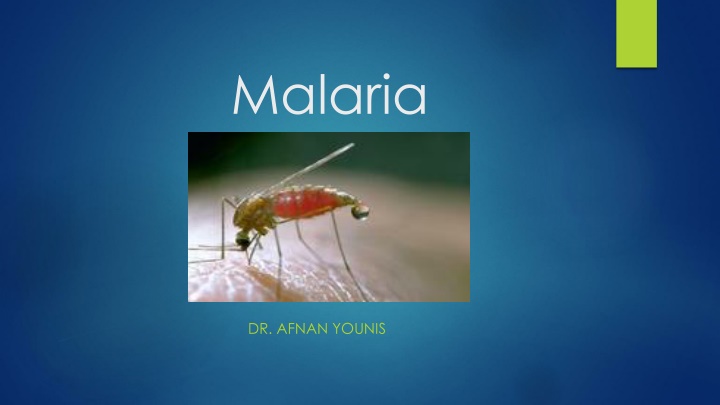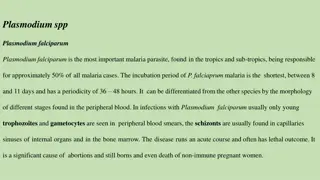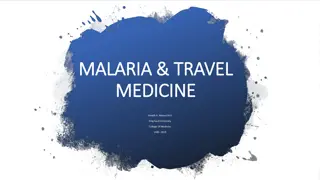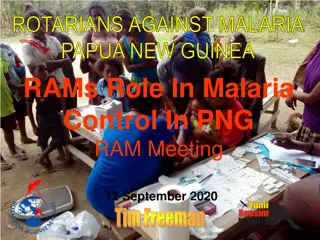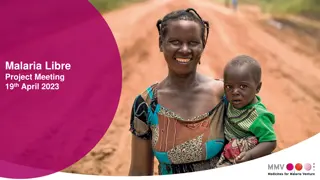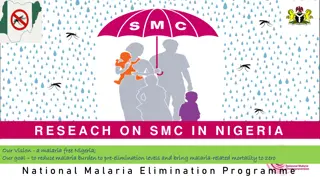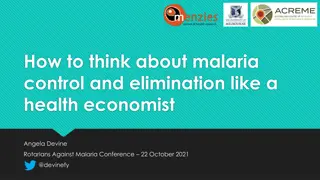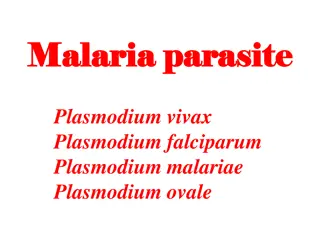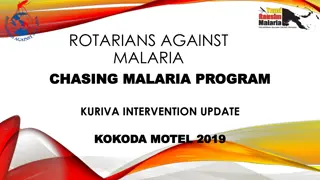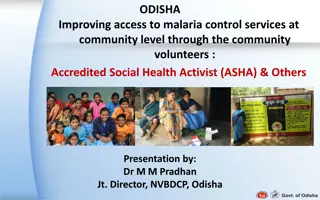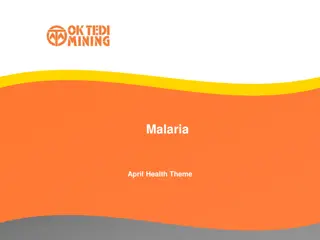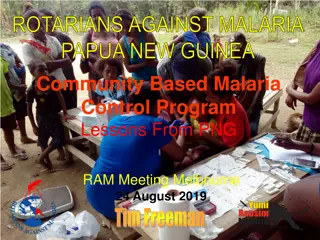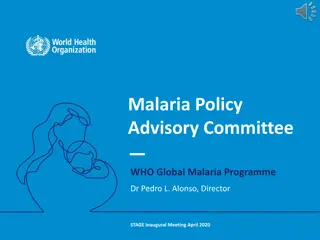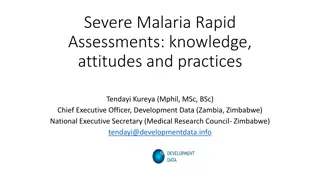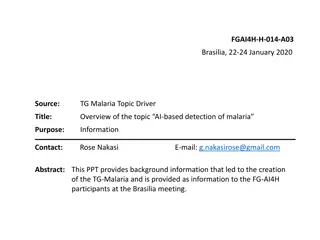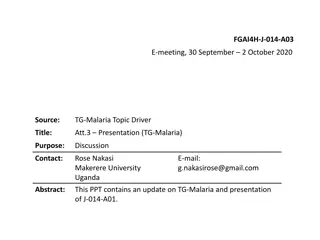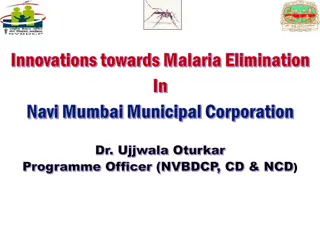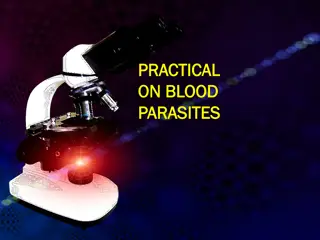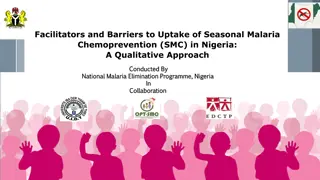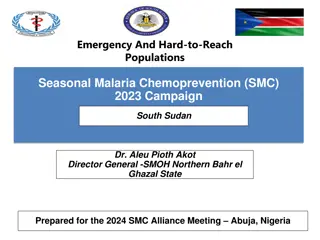Malaria Epidemiology and Prevention
Malaria, a life-threatening disease transmitted by infected mosquitoes, remains a global public health issue. The content covers the epidemiology, clinical presentation, transmission modes, risk factors, prevention, and control strategies. It highlights the significant decrease in malaria cases and mortality rates globally, with specific insights into malaria in Saudi Arabia. Imported malaria poses a resurgence threat through asymptomatic travelers from endemic areas.
Download Presentation

Please find below an Image/Link to download the presentation.
The content on the website is provided AS IS for your information and personal use only. It may not be sold, licensed, or shared on other websites without obtaining consent from the author.If you encounter any issues during the download, it is possible that the publisher has removed the file from their server.
You are allowed to download the files provided on this website for personal or commercial use, subject to the condition that they are used lawfully. All files are the property of their respective owners.
The content on the website is provided AS IS for your information and personal use only. It may not be sold, licensed, or shared on other websites without obtaining consent from the author.
E N D
Presentation Transcript
Malaria DR. AFNAN YOUNIS
Objectives: Epidemiology of malaria Clinical picture Mode of transmission Risk factors Prevention and control
Malaria is a life-threatening disease caused by Plasmodium parasites that are transmitted to people through the bites of infected mosquitoes. Malaria is responsible for approximately 1-3 million deaths per year
Epidemiology Between 2000 and 2015, malaria incidence fell by 37% globally. During the same period, malaria mortality rates decreased worldwide by 60% among all age groups, and by 65% among children under 5. An estimated 6.2 million malaria deaths have been averted globally since 2000. In 2014, 13 countries reported zero cases of the disease and 6 countries reported fewer than 10 cases.
An approximation of the parts of the world where malaria transmission occurs.
Malaria in Saudi Arabia Areas at the southern region are at risk of malaria transmission, specifically Asir and Jizan. The Dominant Malaria Species in Saudi Arabia is P. Falciparum . Saudi Arabia achieved a decrease in malaria cases and case incidence rates of 75%.
Malaria in Saudi Arabia Malaria outbreak in 1998. Since then, only a few cases were reported In 2012 , only 82 cases of malaria were reported.. The proportion of imported malaria has increased from 23% to 99% of total detected cases.
Imported malaria: via asymptomatic travelers from malaria endemic areas, sustains a threat for possible resurgence of local transmission: Workers, immigrants, pilgrims.
Analytical Epidemiology Triad: HOST ENVIRONMENT AGENT
Plasmodium Parasites: The parasites are spread to people through the bites of infected female Anopheles mosquitoes (vector). Five parasite species that cause malaria in humans P. falciparum and P. vivax pose the greatest threat. Other modes of transmission: From mother to unborn child Blood transfusion
Plasmodium Parasites transmission and lifecycle:
Symptoms Early symptoms Severe illness Fever Headache Chills If not treated early might progress to Severe anemia Respiratory distress Cerebral malaria Multiorgan failure
Risk factors: The most vulnerable are persons with no or little immunity against the disease in areas with high transmission (such as Africa south of the Sahara). Young children, who have not yet developed partial immunity to malaria Pregnant women, whose immunity is decreased by pregnancy. Travelers or migrants coming from areas with little or no malaria transmission, who lack immunity.
Immunity against malaria (protection) Genetic Factors: Biologic characteristics present from birth can protect against certain types of malaria: (having the sickle cell trait) Acquired Immunity: newborns in endemic areas will be protected during the first few months by maternal antibodies. Repeated attacks of malaria
Control: The main way to reduce malaria transmission at a community is vector control Insecticide-treated mosquito nets (ITNs) Indoor spraying with residual insecticides Antimalarial medications Vaccination
Insecticide-treated mosquito nets (ITNs) For all at-risk persons Provision of free LLINs Everyone sleeps under a LLIN every night.
Indoor spraying with residual insecticides At least 80% of houses in targeted areas are sprayed Protection depends on type of insecticide.
Antimalarial medications To travelers Pregnant women Infants in endemic areas Seasonal chemoprevention
Vaccine Still under trial
Prevention And Control Of malaria in KSA The current elimination strategy in Saudi Arabia focuses mainly on: Targeting high risk areas for sustained preventative measures such as (Long lasting insecticide treated 1. nets, Indoor residual spraying) Management of infection through rapid confirmed diagnosis and treatment. 2. Individual case follow up and reactive surveillance with appropriate treatment and vector control. 3. Active case detection at borders with screening and treatment. 4.
References: http://www.who.int/mediacentre/factsheets/fs094/en/. http://www.cdc.gov/malaria/about/biology/human_factors.html
